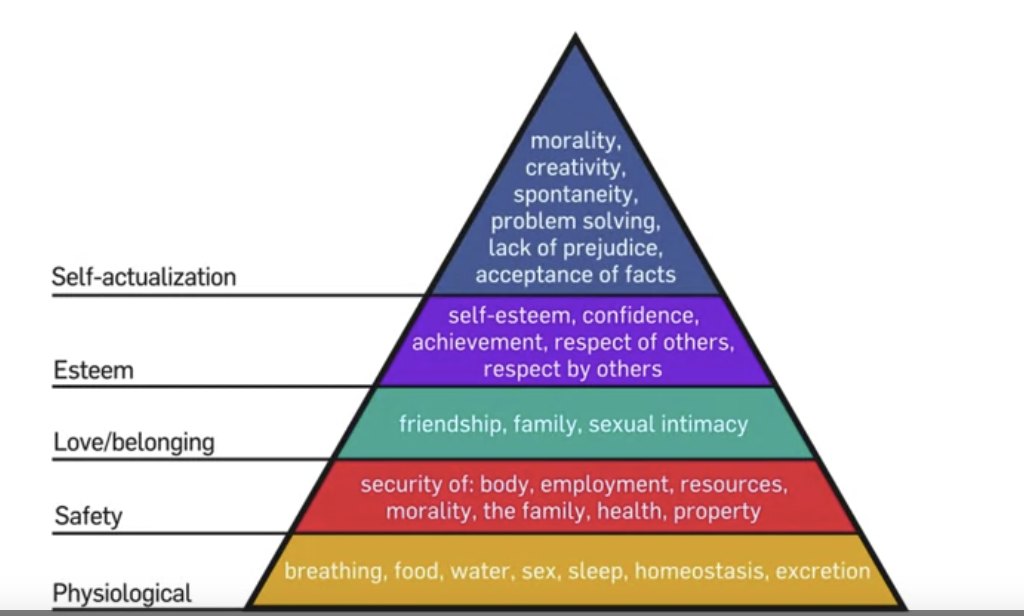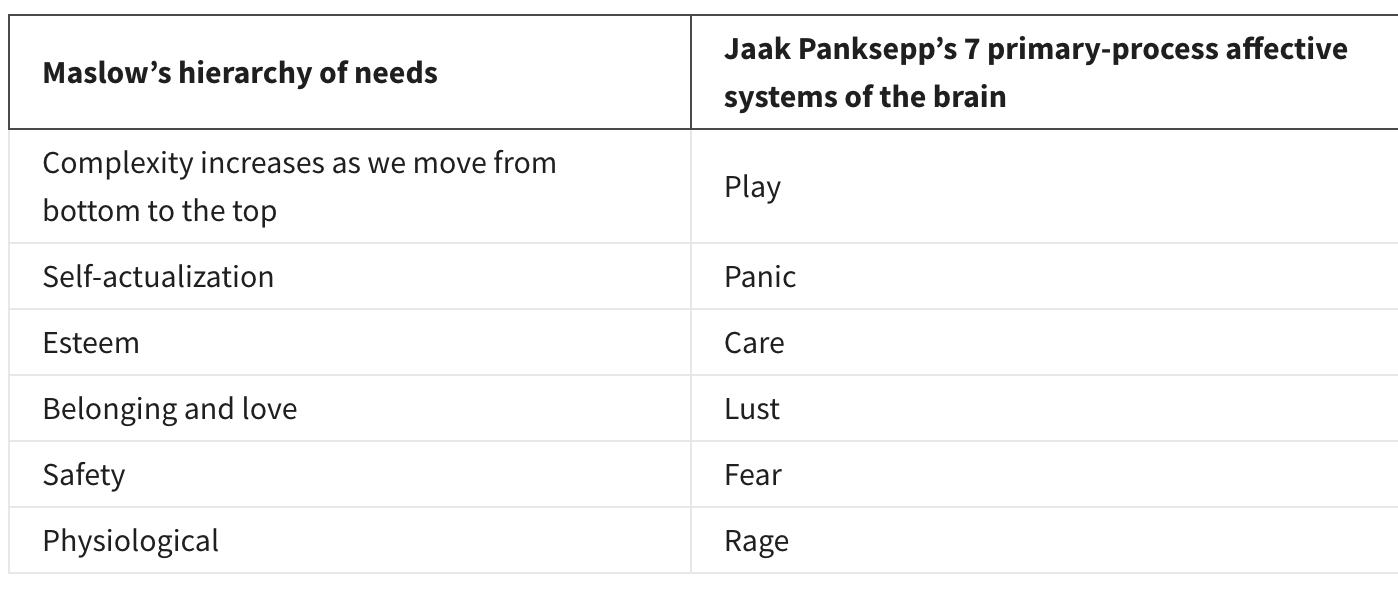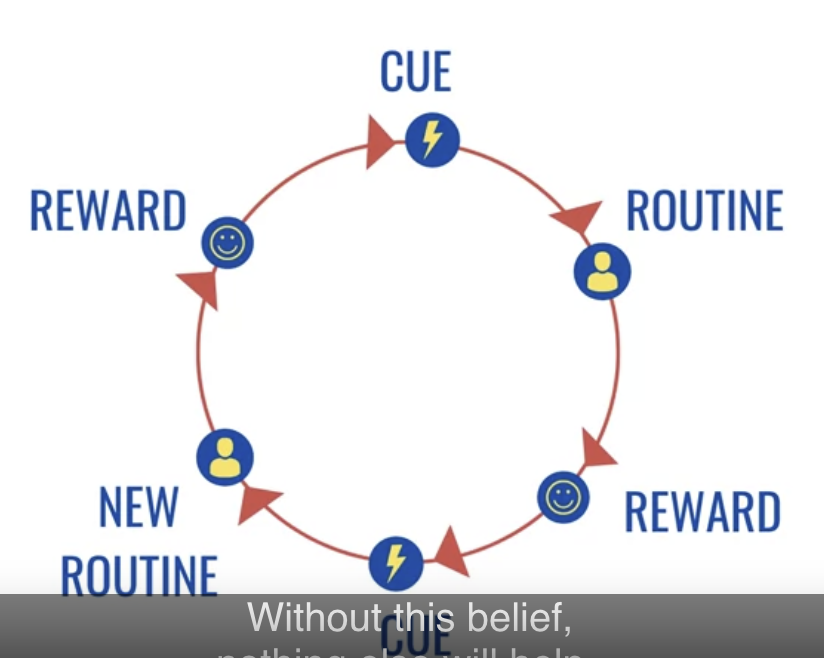Neuroscience of Change
Survival system
- Amygdala - fight or flight response
- Fight, Flight and Freeze stress response
- processing anxiety
- assign meaning, depending on our frame of mind
- negativity bias - we often fill in the blanks with worst case scenarios
- What does that mean to me?
- too many changes lead to paralysis
- communicate clearly about the why of changes
Agile Workbook
[[AgileWorkbook.pdf]]
Seeking System
Maslow Pyramid of needs

Why Maslow’s Hierarchy Of Needs Matters
Survival systems
- Dopamine - pleasure

Maslow’s Hierarchy of Needs
Maslow’s model is often depicted as a pyramid and includes the following levels, from bottom to top:
- Physiological Needs: Basic needs for survival, such as food, water, and shelter.
- Safety Needs: Needs for security and safety.
- Love and Belonging Needs: Needs for affection, relationships, and belonging.
- Esteem Needs: Needs for self-esteem, respect, status, recognition, and freedom.
- Self-Actualization Needs: The need to realize one’s full potential and seek personal growth and peak experiences.
Panksepp’s 7 Emotional Systems
Panksepp identified seven primary emotional systems in the brain:
- SEEKING: Encompasses the urge to explore, learn, and extract resources.
- RAGE: Associated with frustration, anger, and aggression.
- FEAR: Linked to anxiety, worry, and behaviors associated with avoiding harm.
- LUST: Tied to sexual desire and behaviors.
- CARE: Involves nurturing, caring for others, and forming social bonds.
- PANIC/GRIEF: Related to feelings of loneliness and loss.
- PLAY: Connected to joy, playfulness, and relaxation.
Possible Correlations
-
Physiological Needs and SEEKING: The SEEKING system could be activated when individuals are motivated to fulfill basic survival needs, such as searching for food or shelter.
-
Safety Needs and FEAR: The FEAR system directly correlates with safety needs. When safety is threatened, fear responses are triggered.
-
Love and Belonging Needs with CARE and PANIC/GRIEF: The CARE system is active in forming attachments and social bonds, which are crucial for love and belonging. Conversely, the PANIC/GRIEF system might be activated when these needs are not met, leading to feelings of loneliness or loss.
-
Esteem Needs with SEEKING and PLAY: The SEEKING system can drive individuals to achieve and gain recognition, fulfilling esteem needs. The PLAY system might also be involved, as it can relate to social status and esteem gained through social interactions and achievements.
-
Self-Actualization Needs with SEEKING and PLAY: Fulfilling self-actualization needs may involve the SEEKING system as individuals explore and realize their potential. The PLAY system might also be relevant, as creativity and experimentation can be parts of self-actualization.
-
LUST and Love/Belonging Needs: The LUST system is clearly linked to romantic and sexual relationships, which are part of the love and belonging level in Maslow’s pyramid.
-
RAGE and Esteem/Safety Needs: The RAGE system may be activated when an individual’s esteem is threatened or when there is a direct threat to their safety.
Conditioning
- Choice
- Environmental conditional
- Participation
Deconstruct your own conditioning
Mirror Neurons
Understand, immitate and relate with others Be aware of loading fear from others on yourself
Negativity Bias
Negativity bias refers to the human tendency to place far greater significance on negative events, emotions or information.
Week 2 - Taking Action
- Develop and Deepen self awareness
- through reflection on actions from me and others
- It is a journey
- Have patience
- Work with handwriting for reflection - this enables more brain areas and leads to higher creativity
Envisioning
- envision end goal by answering What, Why, By when
- What do I want?
- How do I want to deal with uncertainty?
- Why do I have to make this change?
- What is my realistic timeline for this change.
- Do this via a self writing exercise on What, Why, When with shortlisting after brainwriting
Deconstructing Fears
- face your fears and your connecting with these fears to avoid sabotaging your goals
Mind Mapping
- around my beliefs and associations to change, what words about change come to my mind
- Note: I can do that with Excalidraw
- does not have an order
- grows around a main theme
- add a title and date
- identify high, medium and low beliefs
- high: cause so much pain that you would do anything to avoid that
- medium: serious discomfort
- pick the associations that you want to replace and find replacement words or short phrases
Worst Case Scenario - WCS modeling
- do it in writing
- reflect on a change that is causing a discomfort
- what will happen in the worst scenario of this change
- what emotions would I experience
- How would I change it?
- separate facts from thoughts
- 📖 Man’s search for Meaning by Victor Frankl
Week 3 - Building a new Mindset
Stories we tell ourselves
Negative stories we tell ourselfes:
- victim - it is not my fault
- helpless - nothing I can do about it
- villian - another one to blame
- hero - I’m the only one who can do it
Ask: Is it a story or a fact?
[[AgileWorkbook_V2.pdf]]
Agile Leader Mindset
- Growth Mindset (Linking: [[From fixed mindset to growth mindset- the complete guide|From fixed mindset to growth mindset- the complete guide]] )
- Empower teams - also via delegation
- Observation, experimentatoin and innovation
- servant leadership role
Habit Forming
- [[Atomic Habits - James Clear]]

- queue, routine, reward
- 📖 thw power of habit

- start with the belief that change of an existing habit is possible
- need a strong belief in the new habit - and create a powerful reason to change
- keep cue and reward the same and replace the routine with a new routine
- it takes about 66 days to form a habit (study by Philippa Lally - How habits are formed)
- time to develop a habit between 18 - 254 days
Reframing
- for changing the narrative
- access the situation from different angles (Note: use ChatGPT for getting different ideas on looking at a situation from different angles)
Anchoring
- NLP tool
- Maslow Dog
- e.g. with a moment you achieved something great through a change you made … recap emotions, situations, how did I feel, voice, smile, behavior
- connect that with an anchor - e.g. a clap of your hands, or turning your ring 2 times
- should be something unique
- get into peak state, set the anchor - and repeat several times
PDSA Cycle
- Plan-Do-Study-Act

- add a tracking

Week 4 - Leader Self Care Practices
Positive Psychology
- Martin Seligman - main figure of positive psychology
- focus on things that make us flourish - happiness, gratitude, resilience
- PERMA model - to achieve a fulfilling live
- Postive Emotions
- Engagement
- (positive) Relationships
- Meaning
- Accomplishment
Your source of energy
- to P+E of the Perma Model
- look at introvert, extravert and ambivert classification
-
What are my sources of energy?
- VIA Character strengths survey
- What is ambivert
Stillness
- shifting to observing mode - mindfulness and meditation
- guided meditation, timed meditation, Zen-sitting, transcendental meditation
- Insight Timer app
Reflection
- acknowledge and process our thoughts and experiences
- 3 types of reflection
- awareness building
- What did I experience today?
- How am I feeling right now?
- What have I given today?
- What do I experience when facing change?
- What are my fears around change?
- transformation focused - to find ways to improve and learn
- What could I do differently that I did today?
- How can I make this happen?
- What did I learn from this experience?
- What action could I take the become more resilient next time?
- state setting - to set a specific emotional state
- What am I excited in my life right now?
- What can I commit to doing today to feel more energized than I felt before?
- awareness building
- Use journaling and handwriting daily
Gratitude
- consistently recognize the positives in our lives
- What can I be grateful for?
- Some techniques:
- keep a journal
- ask yourself what are you grateful for
- write a gratitude letter to someone
- say thank you
- set a reminder in your calendar to pause and feel gratitude
Week 5
- want, get to
Overcoming pitfalls
- not having enough time
- accountability to ourself or making a pact with someone
- lack of commitment to the process
Daily rituals
- pay attention to our habits
- reflection, stillness, gratitude
- 📖 Mini Habits - Steven Guise
- take tiny steps each day
Power of Association - pleasure and pain
- link pain to something you want to remove and pleasure to something to establish
- pain:
- what it the long term implication of a behavior
- how will it influence my career in 1,2,5,10 years from now
- what is the cost connected
- What opportunities and experiences will I miss out on if I continue having these thoughts and beliefs?
- pleasure:
- how will my life improve as a result of this change in 1, 5, 10, and 20 years
- What will I gain by changing?
- What could I achieve if I change this belief?
New experiences
- engage in new experiences
Certificate
[[Coursera DRFTKP36SAWV.pdf]]